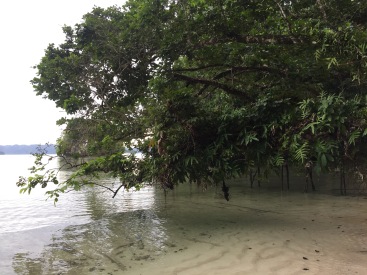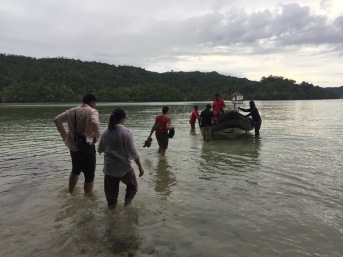
In Search of Birds of Paradise
I’m on the beautiful traditional adventure liveaboard Tiger Blue. We are traveling along the Alfred Wallace routes here from Raja Ampat, to the clove island of Ternate. We are anchored off the village of Bessir on the island of Waigeo in Raja Ampat, West Papua. Its a 4am wake up call & its raining. We have cups of coffee or tea & hope for the rain to subside. There’s only this one chance on this trip to try to find the birds of paradise. Some of us don’t have rain gear, its dreary but then we decide to go for it anyway.
We start off from Tiger Blue in the tender in the dark. It stops raining heavily. Our local guide from the village of Bessir is with us at the front of the tender & in the drizzle we land in the shallows & with torches on, we wade to the narrow beach under the heavy dark canopy of the rain sodden trees growing thick on the shoreline.
Everything is wet. We rinse our feet of sand & put on our shoes. Then with our guide in the lead with a torch we start the hike up through this forest in single file. It belongs to his family. The guide walks slowly & makes no sound as he pads up the slope & over stones, rocks & logs. He is in no hurry & we all have to deliberately slow down to adjust to his pace. Along the way he stops to clear leaves, fronds & cuts away branches that have fallen during the storm. It is not a particularly difficult hike but it is uphill with a couple of steep parts to negotiate. There’s also a few fallen trees to climb over. The crude hand rails made a while ago with tree branches, are quite rotten & one falls away as someone puts too much weight on it as they pull themselves up the slope.
The jungle starts to light up a bit & its easier to see our way. After about 20 minutes we climb a steep wooden ladder up a slope & arrive at the hide, a crude canvas lean-to hut with a bench inside. It is all damp & steamy. There are holes through which you can view the display trees used by Paradisaea rubra for their courtship displays. We wait in silence, just the odd cough to give us away. A male bird of paradise calls & our guide mimics the call in order to encourage other males to join the tree. There are 2 high up in the branches. We catch a glimpse of them. There is a flurry of excited whispers & movement in the hide as we shuffle around to give each other a turn to look up into the branches. A couple of females come in but not much happens. There isn’t enough competition.
Our guide patiently mimics more calls, some very tentative, waiting for a reply. He calls more enthusiastically if he gets a response. It’s not easy. We watch him press a finger to his nose as he squeaks out the call that gets the competitive male birds excited. There is some movement in the trees as the birds half heartedly begin a courting display. We take turns to look through the open holes in the canvas & some of us get a better look at the birds than others.
We continue our patient & silent watch for about an hour but the mosquitoes have found us and there is a little boredom setting in. Our guide has one last go at calling. Two females fly high into a nearby tree & wait to see if there will be any male action this morning. The wet rain has upset the atmosphere & put a damper on everything so most of the males have stayed away from the display tree.
Bird watching is not an exciting past time. Most times it is about having the stubborn patience to wait for the bird to just show up. You have to constantly think past the feeling of being hard done by & disappointment. At best, there will be no rain & your hide is comfortable. Ah well, maybe next time.
The dawn chorus of birds in the jungle as we make our way back down the hill in the morning light, makes up for the lack of visuals on the birds of paradise. The act of getting on a little tender, wading in the shallows & starting the hike in the dark is exciting. Silencing yourself while you listen to the sounds of the morning rising in the steamy damp jungle is something we should try to do more often. It reconnects ones whole being to the natural elements, taking you a little out of your own comfort zone. The calls of the butcher birds & other unknown birds, the blurred vision of white cockatoos as they fly through the trees, their caws heard all over the islands. And then there was the wonderful sighting of the black cockatoo with its red crest, Burung Kakak Tua Raja Hitam. That is definitely one for the bird list!
I’ve been lucky enough to have trekked up to this location in Bessir a few times now & only once can I describe the end game as magnificent. 8 birds in full, crazy, noisy display. I say that has been great odds. It is more likely that you have to be content to have caught just a glimpse of the Red Birds of Paradise. We are all lucky that they are still around for us to get excited enough to go look for them. Their numbers are very much threatened & it is likely that soon, their numbers will dwindle to just above none. This is a very sad prospect.
Alfred Russel Wallace was fascinated by them & he desperately wanted many of the birds of paradise in his collection. He struggled to find them, shoot them, collect them from the locals. He found it difficult to keep them alive. All of the ones he tried to keep died within just a few days, despite eating well & greedily. He was completely at a quandary over this. Wallace was also constantly at the mercy & competition from the Sultan of Ternate who had everyone on his side when it came to the procurement of these birds, so coveted for their magnificent feathers. During Victorian times, their feathers were in any fashionable persons hat, the trade in feathers so huge that numbers of these birds were forever affected & unable to recover from the fall.
Today they are at risk, not so much from the collection of feathers, but from the destruction of their natural environment. It is hard to expect the people of the villages on these remote islands to wave away prosperity & modernity gained from tourism & other related businesses. As health & housing improves, as modern gadgets become more affordable, as tourism increases, these villages will prosper & expand, & the impact on their immediate environment, no matter how small, will be marked.
This village of Bessir was where Alfred Wallace himself had a house. He stayed here with the firm goal of collecting the Red Bird of Paradise. When you are standing in the village looking out towards the water, you do get the feeling that it has not changed that much. It is here, in this tiny area, that these birds were exclusively found & they still are today. For now that slow, dogged patience & determined silence required of a small but avid birdwatching community, most often dismissed as boring by other kind of adventure types, ensures that these birds have a chance to regroup & stay amongst us in this world. Paradisaea rubra cannot withstand a frenzy of excited activity around them. A glimpse of them on a wet damp day is satisfaction enough to make me feel happy knowing that they are still with us on this earth.
Get on a bucket list trip like this:
Let Tiger Blue take you on a voyage of exploration & discovery along the Wallace route. There are various itineraries, that can be customized to your interests, available beginning in Sorong, West Sorong taking in his journeys around the islands of Raja Ampat, his journey from Raja Ampat to Gag & Ternate, as well as sailing south Passing through the islands around Misool (which eluded him completely despite his desire to explore there), to the Banda Islands & Ambon. These trips take place in season at certain times of the year.
Go to <www.tigerblue.info> for more information. Contact <sail@tigerblue.info> for general enquiries.
Check out the Tiger Blue Instagram page: @sailtigerblue
& our Facebook page: Tiger Blue, Voyage Indonesia
Activities are all included and you can expect to dive, snorkel, hike, kayak, waterski, paddle board, walk around villages & markets, hang out on the beach.
What to bring:
Swimsuits, a rasher top (against sunburn & jellies), leggings (against sunburn & jellies), good walking shoes or a pair of hiking sandals that are easier to dry after wet weather, a rain poncho or lightweight raincoat, sarong, small selection of clothes, a light colored set of walking pants & top (better against mosquitoes), a sweatshirt (mainly for the airconditioned flights around Indonesia), your own special medications. There is a selection of wetsuits, rasher tops, all dive & snorkeling equipment on board.





























